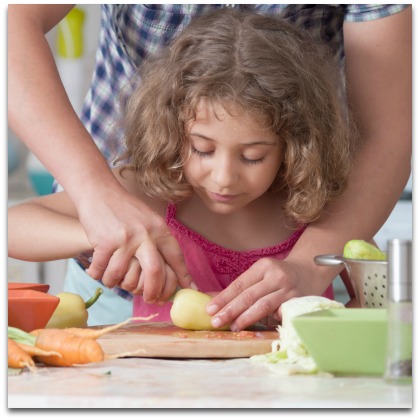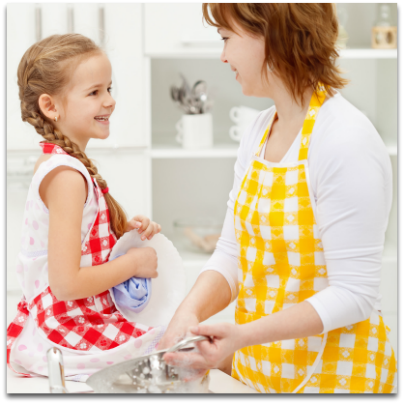 My four-year-old makes the fluffiest frittata I’ve ever tasted. She also loves preparing sauces and salad dressings, dreaming up her own sandwich recipes, and baking lemon-ricotta cookies.
My four-year-old makes the fluffiest frittata I’ve ever tasted. She also loves preparing sauces and salad dressings, dreaming up her own sandwich recipes, and baking lemon-ricotta cookies.
This might sound extraordinary. But I promise, my daughter doesn’t have any special talent for the culinary arts. And I’m not a professional chef – or even a particularly good cook.
Our “secret” is simply cooking together a few times a month – about two years of mommy-daughter afternoons in the kitchen and counting.
In the United States today, the prevailing views about cooking with kids is remarkably pessimistic.
It’ll take me twice as long to get the food on the table with the kids underfoot.
She just makes such a mess every time I let her help!
Cooking with a toddler? Are you kidding? That’s so dangerous!
Such skepticism is exacerbated by broader societal trends that keep kids out of the kitchen. For one, as children devote more time to ever-increasing academic commitments and organized activities, fewer hours are left to help out at home.
Even adults are cooking less, largely due to busy schedules and the convenience of takeout or ready-to-eat grocery store meals. As a result, many parents consider cooking with kids a complex task best saved for special occasions like holiday traditions or formal cooking classes.
But parent-and-child cooking doesn’t need to be an elaborate production! On the contrary, involving children in routine breakfast, lunch, or dinner prep can have incredible benefits for your entire family.
Why Cook Together?
 Starting to cook with a small child can feel like beginning a new workout regimen. In the short term, it’s an investment of time and energy. But before long, you’ve built a habit, the “work” becomes enjoyable, and you and your kiddo start reaping the benefits.
Starting to cook with a small child can feel like beginning a new workout regimen. In the short term, it’s an investment of time and energy. But before long, you’ve built a habit, the “work” becomes enjoyable, and you and your kiddo start reaping the benefits.
And those benefits are numerous!
#1. Eat healthier
Cooking with your kids can boost their health – and yours. Research has shown that spending time cooking encourages children to make healthier food choices and try new fruits and vegetables. And regardless of the specific recipe, home-cooked food tends to be healthier than restaurant food or prepared grocery store meals.
#2. Get active
Cooking gets kids moving. In our society, where children spend so much of their time sitting – whether in a classroom, in a car, or in front of a screen – an hour of bustling about in the kitchen offers some much-needed physical activity.
#3. Encourage independence
We’ve all heard about the dangers of helicopter parenting and our children’s need for a bit of age-appropriate risk. What better place to offer opportunities for controlled risk-taking than the kitchen! Children can navigate challenges like hot ovens and sharp knives with gradually decreasing parental support.
#4. Develop academic skills
Who needs worksheets? Cooking together provides the perfect environment for hands-on learning. In an interview, Sally Sampson, the founder of ChopChop Family, a nonprofit that helps families cook and eat together, told me, “Cooking covers almost every subject – you can talk about other cultures, math and money, science, the history of a certain food and who made it.”
Sally explains that these learning opportunities can be tailored to any age – parents might ask younger children to count out 2-3 tomatoes for a recipe, while older kids might practice division or fractions by halving an entire recipe.
#5. Get creative
While at first glance, cooking might appear to be largely prescriptive, relying on specific instructions and exact measurements, most recipes leave room for creativity. My daughter and I love to put our own special touches on our creations. We might experiment with something as simple as picking out a unique color combination for a cookie glaze or take on a harder challenge like swapping out ingredients or even developing new recipes.
#6. Save time
I love watching my daughter develop skills in the kitchen, but I’ll be honest: I’m even more excited about saving some time in my busy day. Some moms cook while the kids are in school or plop them in front of a tablet to get dinner together. By moving meal prep to our family time, I’m able to use my kid-free hours to catch up on work or relax with a book. And, as Sampson points out, “if you teach your children to cook, eventually they’ll be cooking dinner for you.”
#7. Bond with your kids
There are hundreds of ways to bond with your child, but cooking is one of my favorites. I love that it’s something we can do together for years, if not decades. I love how accessible it is – available every day year-round, and we don’t even need to leave the house. I love that cooking offers both opportunities to talk and moments of working together in companionable silence. And you can’t beat the shared pride of creating something delicious together (and consuming it shortly thereafter)!
What You Need to get Started
If you’re ready to experience all the advantages of cooking as a family, here’s what you need to know to get started.
If you have younger children, your most important investment before bringing them into the kitchen will be a step stool. The exact product will vary with your child’s height – just make sure he or she can easily reach the counter top. The Learning Tower is popular among families with toddlers or preschoolers, but quite expensive. As an alternative, we chose this IKEA stepstool for 10% of the cost; we’ve used it for several years and it’s still going strong.
 Less essential but still quite helpful is a kid-size apron. In addition to the practical benefits of keeping your little chef (somewhat) clean, aprons are useful for their symbolic value. Even a 2-year-old can understand and get excited about the ritual of putting on aprons to start Family Cooking Time. Finally, you’ll probably find that special rules for the kitchen are easier to enforce with this clear delineation: “Remember, when we have our aprons on, the rule is no running!”
Less essential but still quite helpful is a kid-size apron. In addition to the practical benefits of keeping your little chef (somewhat) clean, aprons are useful for their symbolic value. Even a 2-year-old can understand and get excited about the ritual of putting on aprons to start Family Cooking Time. Finally, you’ll probably find that special rules for the kitchen are easier to enforce with this clear delineation: “Remember, when we have our aprons on, the rule is no running!”
When you’re just starting out, I don’t suggest any purchases beyond the apron and step stool. I know, I know – the Internet is brimming with adorable kid-size spatulas and cupcake trays and potholders. And stocking up on dozens of such “necessities” can feel quite satisfying. But you won’t know what your kid really needs until you’ve spent some time working through recipes together. If you overbuy tools and supplies before you start, there’s a good chance they’ll end up unused, taking up valuable cabinet space.
It’s also important to look through your kitchen for any hazards. Depending on your child’s age, you might want to designate a workspace away from sharp blades and heat sources, move heavy items that might be easily tipped over, and store valuable ingredients well out of reach.
What to Cook
For most of us, cooking with kids conjures images of cupcakes, chocolate chip cookies, mini pizzas, and the like. The problem with these recipes? They’re not exactly healthy, which may be fine for an occasional treat, but not practical if you’re trying to cook together on a regular basis.
Health concerns aside, adults might find such kid-focused recipes pretty bland. Since you’re not trying to make your life any more complicated, it makes sense to choose recipes that the entire family will eat.
 So, when figuring out what to make with your kids, feel free to go beyond children’s menu favorites. I like to choose appealing recipes from my usual go-to cookbooks and review them before we start to identify kid-friendly tasks.
So, when figuring out what to make with your kids, feel free to go beyond children’s menu favorites. I like to choose appealing recipes from my usual go-to cookbooks and review them before we start to identify kid-friendly tasks.
For example, we’ve had great success with Melissa Clark’s Soba Salad with Cucumbers and Roasted Mushrooms, which includes lots of washing, mixing, peeling, and measuring – all tasks my kiddo can handle. And, the end result is flavorful enough for my taste buds and simple enough for hers.
One kid-focused magazine I do use regularly is ChopChop, where my daughter and I have found dozens of healthy and tasty dishes to try together. All of ChopChop’s recipes are designed with little chefs in mind, with clear instructions on what kids can do and where adult help is needed. Some preschooler-friendly ChopChop recipes we’ve tried recently include baked apple French toast, yogurt parfaits, egg sandwiches, and make-it-your-way salad dressing. With older kids, you may want to start with easy recipes to begin with, but should soon be able to try pretty much any recipe you can find in a book or online.
Kid-Friendly Kitchen Tasks
More important than what you’re cooking is how your kids can get involved. Age is one factor in choosing appropriate tasks, but experience and enthusiasm are just as important. Sampson has seen children as young as 4-5 master knife skills in ChopChop’s cooking classes.
She recommends carefully observing what your children are capable of in the kitchen, as well as what they’re drawn to.
Younger children (even children as young as 2 and 3 years old) and culinary first-timers can start building skills and confidence with simple responsibilities. Once they master the basics, you can challenge them with more involved tasks. Here are some ideas to get you started:
Beginner
• Counting out ingredients
• Stirring and whisking batters, dressings or vinaigrettes, hot or cold sauces, and salads
• Pressing buttons – setting the bake temperature on the oven, starting the microwave, or turning on the food processor
• Washing and scrubbing fruits and vegetables
• Mashing potatoes or other veggies
• Tearing lettuce into pieces for a salad
• Spreading cream cheese or butter on bread, crackers, etc.
Intermediate
• Measuring and pouring wet and dry ingredients
• Peeling vegetables
• Using a citrus juicer to juice limes or lemons
• Cracking raw eggs into a bowl; peeling hard-boiled eggs
• Shaping ground meat into patties for burgers or meatballs
• Using a food thermometer
• Finding the right ingredients in the fridge, pantry, or spice drawer
• Grating or zesting cheese, veggies, citrus, etc.
• Using a slow cooker or rice cooker
Advanced
• Working with heat – for instance, simmering ingredients on a stove top, frying veggies, eggs or meat, or placing a dish into the oven
• Working with knives – slicing, dicing, chopping, and mincing
• Learning to use gadgets like a stand mixer, waffle iron, or panini press
• Choosing a recipe and preparing it from start to finish
Avoiding Common Obstacles
 Still doubting whether cooking with kids would work in your home? Here are some common parental concerns about kids in the kitchen, along with tips on how to handle them:
Still doubting whether cooking with kids would work in your home? Here are some common parental concerns about kids in the kitchen, along with tips on how to handle them:
“We’re just too busy to cook.”
These days, kids and adults alike are juggling jam-packed schedules. But you have to eat… and you want to spend time with your kids. So get creative and carve out some time times when you can combine the two.
If making dinner together feels too time-consuming, can you work on an after-school snack or prep the next day’s lunches? Or if school nights are too overwhelming for any cooking, what about Friday night dinners or lazy weekend brunches?
“Cooking with children is too messy.”
Little chefs will rarely be able to stick to adult standards of cleanliness. But while they might make a mess, there’s no reason they can’t help clean it up.
ChopChop’s Sampson recommends incorporating cleanup into your routine. “Parents should make cleaning up part of the process,” she says. “I think that’s really important – so kids don’t feel like they can make a mess in the kitchen, walk away, and the parent cleans it all up.”
Even the youngest kids can help throw away trash, wipe a counter, or load a dishwasher. You can also teach kids to put away ingredients, wash and dry dishes, and sweep the floor.
“I’m a terrible cook!”
If you’re a novice in the kitchen, cooking with your kids can help you as much as it helps them. In addition to the nutritional and health benefits outlined above, you’ll gain the satisfaction of mastering a new skill. And your pursuit of lifelong learning will serve as an excellent model for your children.
Like with any new activity, the key is to start small – cooking is more likely to become a regular and rewarding habit if you set achievable, concrete goals. Start by preparing simple snacks or easy no-cook entrees. As you and your kids gain confidence, you can try more involved recipes.
The 2-Minute Action Plan for Fine Parents
Before embarking on your cooking adventures, take a few minutes to consider where you are today. Here are some questions to reflect on:
• Do you and/or your partner cook often? Do your children ever observe or participate?
• What are your children’s biggest interests? Do you see any connections between these interests and helping in the kitchen?
• How do you feel about cooking? (Be honest!) What are your concerns about cooking with your kids?
The Long-Term Action Plan for Fine Parents
Now that you’ve considered the role cooking plays in your family life today, let’s make a plan. Here are 4 steps to get you and your kids started on some culinary masterpieces:
1. Space: Take a look around your kitchen and make any necessary adjustments to prepare it for pint-size chefs.
2. Time: Figure out the best times for culinary fun in your family’s schedule. To start, aim to get your kids into the kitchen 2-4 times per month.
3. Recipes: Look through some cookbooks or search for appealing recipes online. Consider which of your go-to recipes include kid-friendly tasks. Choose several recipes to get started.
4. Ingredients: A few days before your first planned cooking activity, check to make sure you have all the ingredients you need.
I love cooking with my three year old son. It’s great daddy and son time. One great benefit has been his increased appetite. He’s a finicky eater but will always take 2-3 bites of something we cooked (even capers from our chicken piccata). He did burn his finger one night when we were making pancakes on the griddle and I felt terrible but he now has the greatest respect for something I say is hot. Great article and great way to produce something in our family life!
I love cooking but I’m still not open about teaching my daughter how to cook but I’m just too afraid if she’ll get harm out of it. She was already 5 and I’m still hesitant to make a move.
Thanks for sharing this article.